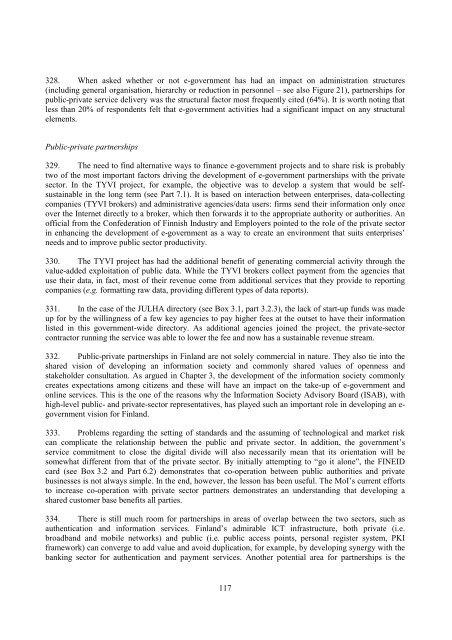e-GOVERNMENT IN FINLAND - ePractice.eu
e-GOVERNMENT IN FINLAND - ePractice.eu
e-GOVERNMENT IN FINLAND - ePractice.eu
You also want an ePaper? Increase the reach of your titles
YUMPU automatically turns print PDFs into web optimized ePapers that Google loves.
328. When asked whether or not e-government has had an impact on administration structures<br />
(including general organisation, hierarchy or reduction in personnel – see also Figure 21), partnerships for<br />
public-private service delivery was the structural factor most frequently cited (64%). It is worth noting that<br />
less than 20% of respondents felt that e-government activities had a significant impact on any structural<br />
elements.<br />
Public-private partnerships<br />
329. The need to find alternative ways to finance e-government projects and to share risk is probably<br />
two of the most important factors driving the development of e-government partnerships with the private<br />
sector. In the TYVI project, for example, the objective was to develop a system that would be selfsustainable<br />
in the long term (see Part 7.1). It is based on interaction between enterprises, data-collecting<br />
companies (TYVI brokers) and administrative agencies/data users: firms send their information only once<br />
over the Internet directly to a broker, which then forwards it to the appropriate authority or authorities. An<br />
official from the Confederation of Finnish Industry and Employers pointed to the role of the private sector<br />
in enhancing the development of e-government as a way to create an environment that suits enterprises’<br />
needs and to improve public sector productivity.<br />
330. The TYVI project has had the additional benefit of generating commercial activity through the<br />
value-added exploitation of public data. While the TYVI brokers collect payment from the agencies that<br />
use their data, in fact, most of their revenue come from additional services that they provide to reporting<br />
companies (e.g. formatting raw data, providing different types of data reports).<br />
331. In the case of the JULHA directory (see Box 3.1, part 3.2.3), the lack of start-up funds was made<br />
up for by the willingness of a few key agencies to pay higher fees at the outset to have their information<br />
listed in this government-wide directory. As additional agencies joined the project, the private-sector<br />
contractor running the service was able to lower the fee and now has a sustainable revenue stream.<br />
332. Public-private partnerships in Finland are not solely commercial in nature. They also tie into the<br />
shared vision of developing an information society and commonly shared values of openness and<br />
stakeholder consultation. As argued in Chapter 3, the development of the information society commonly<br />
creates expectations among citizens and these will have an impact on the take-up of e-government and<br />
online services. This is the one of the reasons why the Information Society Advisory Board (ISAB), with<br />
high-level public- and private-sector representatives, has played such an important role in developing an egovernment<br />
vision for Finland.<br />
333. Problems regarding the setting of standards and the assuming of technological and market risk<br />
can complicate the relationship between the public and private sector. In addition, the government’s<br />
service commitment to close the digital divide will also necessarily mean that its orientation will be<br />
somewhat different from that of the private sector. By initially attempting to “go it alone”, the F<strong>IN</strong>EID<br />
card (see Box 3.2 and Part 6.2) demonstrates that co-operation between public authorities and private<br />
businesses is not always simple. In the end, however, the lesson has been useful. The MoI’s current efforts<br />
to increase co-operation with private sector partners demonstrates an understanding that developing a<br />
shared customer base benefits all parties.<br />
334. There is still much room for partnerships in areas of overlap between the two sectors, such as<br />
authentication and information services. Finland’s admirable ICT infrastructure, both private (i.e.<br />
broadband and mobile networks) and public (i.e. public access points, personal register system, PKI<br />
framework) can converge to add value and avoid duplication, for example, by developing synergy with the<br />
banking sector for authentication and payment services. Another potential area for partnerships is the<br />
117
















